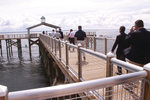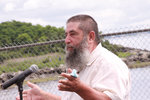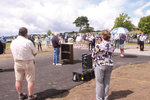The Larry Mouradjian Rocky Point Fishing Pier officially opened Wednesday morning after more than a year of construction, and even more years of planning. The new pier is a T-shaped, 280-foot long timber structure with rails, built-in
This item is available in full to subscribers.
We have recently launched a new and improved website. To continue reading, you will need to either log into your subscriber account, or purchase a new subscription.
If you are a current print subscriber, you can set up a free website account by clicking here.
Otherwise, click here to view your options for subscribing.
Please log in to continue |
|



The Larry Mouradjian Rocky Point Fishing Pier officially opened Wednesday morning after more than a year of construction, and even more years of planning.
The new pier is a T-shaped, 280-foot long timber structure with rails, built-in benches and shading. Funding for the $1.8 million project was provided by the Rhode Island Capital plan as well as the Green Economy Bond, a $35 million bond approved by voters in 2016 to invest in beaches, parks and natural areas in the state.
“This new fishing pier is of course absolutely gorgeous,” Megan DiPrete, chief of planning and development for the Rhode Island Department of Environmental Management (DEM) said. “A wonderful addition to our coastal park. We’re thrilled to be able to open it just before this Independence Day holiday weekend.”
The pier is named for Mouradjian, who served as associate director of the DEM before retiring in 2018. Mouradijian spent the majority of his career working for the DEM.
“It’s amazing when everyone comes together in a common vision that results in public access benefit and opportunity, and hopefully you can see the results of that good work and dedication of all those people,” Mouradijian said.
DEM Deputy Director Jason McNamee said that Rocky Point was an accessible and aesthetic location for the pier. Located in central Rhode Island at a park with a fabled history, McNamee hoped that the pier would be a favorite fishing spot for recreational and career fishers.
“Fishing is an important part of Rhode Island social and cultural fabric,” McNamee said. “We are after all the Ocean State. And fishing is also an important driver for the state’s economy.”
According to McNamee Rhode Island’s recreational fishing industry contributes $420 million to the state’s economy, and employs over 4,000 people. He said the pier’s location would allow fishers to catch a variety of fish, from black sea bass to striped bass to bluefish, at different times of year. McNamee also suggested that fish could be attracted to the structure of the pier, boosting fishing opportunities.
“I marvel at what an optimal location this is for a fishing opportunity,” McNamee said. “Such a productive area of the bay with really diverse habitats in close proximity to rocky shore, flat sandy bottom. Everything you need, and so this will likely offer a myriad of fishing prospects.”
Steve Medeiros, executive director of the Rhode Island Saltwater Anglers Association, also said the pier was important since many fishing spots have been blocked by neighboring landowners. He feels that the pier is an opportunity to be a new hub for fishing.
“This new pier will provide a safe place for recreational anglers to catch fish, and hopefully teach the children and grandchildren what a great deal this is,” Medeiros said. “And this is one of the few places in the state where public access for fishing has been created that you can actually catch fish.”
Jonathan Stone, executive director of Save the Bay said that the pier would serve as a place to educate people about marine life and fishing. He encouraged General Assembly members to support Gov. Gina Raimondo’s $64 million clean water and beaches bond proposal that will be on the November ballot.
Warwick Mayor Joseph Solomon advocated for the project when he was a member of Warwick City Council, according to McNamee. Solomon thanked numerous people when he spoke at the ceremony, but emphasized the impact from and on citizens regarding the pier.
“The most important partner in this whole equation is all of you,” Solomon said. “That is most important, because you are the ones who have been supportive of this. You’re the ones that appreciate the beauty and what this has to offer our community. You are the ones that are going to keep this going, long after I’m gone, long after any of us here are gone. There'll be another generation of young saltwater anglers, that’ll be carrying that goal forward. And that was our goal, to maintain a facility that will last for generations.”
Matt Bellisle, senior vice president of the group that engineered the structure, the Pare Corporation, said that there could be future additions to the pier. Bellisle said there is potential to add a steel ferry barge or floating timber docks for kayaks and transient boating, for example.
Rocky Point opened as an amusement park in the 1840s and closed in 1994. Toll Brothers, a luxury home construction company, placed a $25 million bid for the 124 acres. They planned to build 399 housing units. But when the Great Recession hit, Toll Brothers stepped away from development, and the City of Warwick secured a federal grant to purchase 40 acres of shoreline.
Developers then advanced proposals to buy the remaining 84 acres to develop housing. A community group, the Rocky Point Foundation, was formed in an effort to preserve the full park and with their efforts and those of legislators a bond issue appeared on the 2010 ballot. It was overwhelmingly approved by voters and in 2013 the state acquired the rest of the park.
John Howell, president of the Rocky Point Foundation and publisher of the Warwick Beacon, said that the park’s history made the investment even more significant.
“One thing that I think is remarkable about this park and makes it so distinctive from other parks in the stats is you have the memories of people who enjoyed coming here as an amusement park,” Howell said. “There’s an attachment to this place that you wouldn’t find in Lincoln Woods, Beavertail or other parks or even directly across the bay, we’re looking at Colt State Park. This has all those things, it has the woods, has an open field, it has the ocean, maybe not crashing the waves it goes down at Beavertail. So it makes this very special.”
In compliance with Phase 3 social distancing guidelines, the majority of participants wore facemasks and avoided physical contact. About 50 people attended the event.
Comments
No comments on this item Please log in to comment by clicking here